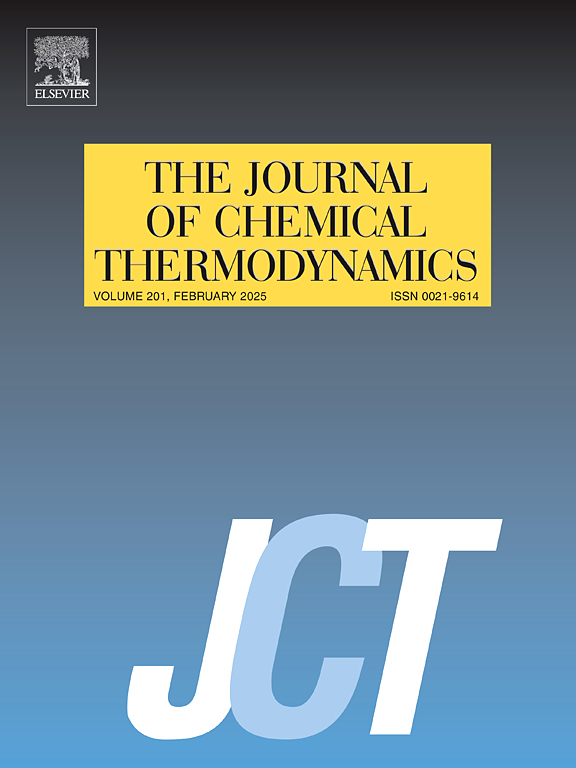Volumetric, acoustic, viscometric and spectroscopic studies of binary liquid mixtures containing triethylamine with 1-propanol, 1-butanol and 1-pentanol
IF 2.2
3区 工程技术
Q3 CHEMISTRY, PHYSICAL
引用次数: 0
Abstract
Densities, speeds of sound and viscosities for the binary liquid mixtures containing Triethylamine with 1-propanol, 1-butanol and 1-pentanol are reported in this article. Densities and speeds of sound were measured at (293.15, 298.15, 303.15 and 308.15) K and 0.1 MPa over the entire range of compositions. Viscosities were measured at (298.15, 303.15 and 308.15) K and 0.1 MPa over whole composition range. The measured data were processed to obtain a number of thermodynamic parameters viz. excess molar volume (), excess isentropic compressibility (), deviation in speed of sound (uD), deviation in viscosity (Δη), excess Gibb’s free energy of activation for viscous flow (). The parameters were analyzed in the light of intermolecular interactions and various effects on these. Spectroscopic investigations (FTIR) were performed to get more information about happenings at molecular level and to find more support for the results. The computed data along with experimental data were also correlated to compositions using Redlich-Kister type polynomial and Jouyben-Acree model respectively. Some existing models of viscosity (Gurunberg-Nissan model, Tamura-Kurata model, Hind-McLaughlin et al. model, Katti-Chaudhri model, McAllister’s three-body interaction model, Heric-Brewer three-parameters model, McAllister’s four-body interaction model) were tested for their application to studied mixtures.

含有三乙胺与1-丙醇、1-丁醇和1-戊醇的二元液体混合物的体积学、声学、粘度学和光谱研究
本文报道了三乙胺与1-丙醇、1-丁醇和1-戊醇二元液体混合物的密度、声速和粘度。在(293.15,298.15,303.15和308.15)K和0.1 MPa下测量了整个成分范围内的声速和密度。在(298.15,303.15和308.15)K和0.1 MPa下测定了整个组成范围内的粘度。对测量数据进行处理,得到了一些热力学参数,即超额摩尔体积(VmE)、超额等熵压缩率(κSE)、声速偏差(uD)、粘度偏差(Δη)、粘性流动的超额吉布自由活化能(∆G∗E)。从分子间相互作用的角度分析了这些参数及其影响因素。光谱研究(FTIR)是为了在分子水平上获得更多的信息,并为结果找到更多的支持。利用Redlich-Kister型多项式和Jouyben-Acree模型分别将计算数据和实验数据与组分进行了关联。测试了一些现有的粘度模型(Gurunberg-Nissan模型、Tamura-Kurata模型、Hind-McLaughlin等人模型、Katti-Chaudhri模型、McAllister三体相互作用模型、herc - brewer三参数模型、McAllister四体相互作用模型)在所研究混合物中的应用。
本文章由计算机程序翻译,如有差异,请以英文原文为准。
求助全文
约1分钟内获得全文
求助全文
来源期刊

Journal of Chemical Thermodynamics
工程技术-热力学
CiteScore
5.60
自引率
15.40%
发文量
199
审稿时长
79 days
期刊介绍:
The Journal of Chemical Thermodynamics exists primarily for dissemination of significant new knowledge in experimental equilibrium thermodynamics and transport properties of chemical systems. The defining attributes of The Journal are the quality and relevance of the papers published.
The Journal publishes work relating to gases, liquids, solids, polymers, mixtures, solutions and interfaces. Studies on systems with variability, such as biological or bio-based materials, gas hydrates, among others, will also be considered provided these are well characterized and reproducible where possible. Experimental methods should be described in sufficient detail to allow critical assessment of the accuracy claimed.
Authors are encouraged to provide physical or chemical interpretations of the results. Articles can contain modelling sections providing representations of data or molecular insights into the properties or transformations studied. Theoretical papers on chemical thermodynamics using molecular theory or modelling are also considered.
The Journal welcomes review articles in the field of chemical thermodynamics but prospective authors should first consult one of the Editors concerning the suitability of the proposed review.
Contributions of a routine nature or reporting on uncharacterised materials are not accepted.
 求助内容:
求助内容: 应助结果提醒方式:
应助结果提醒方式:


